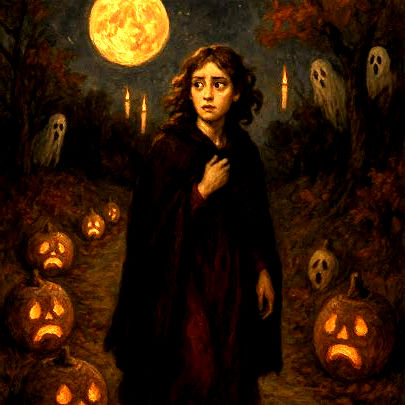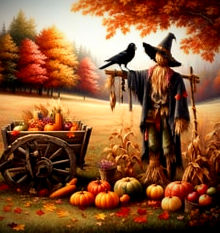Autumn Foods Flavored with Celtic Folklore
- Christine Dorman

- Sep 25
- 8 min read
Updated: 7 days ago

It’s here! Autumn! It’s still in the 90s here in Florida, but I can dream of cool fronts now. In the Northern Hemisphere, Monday, September 22, 2025, was the autumnal equinox, the official start of autumn according to the Gregorian calendar used by most people in the world. For my readers in the Southern Hemisphere, who just had the vernal equinox: Happy Spring!
So, what’s an equinox? There are two equinoxes each year. One marks the start of spring, the beginning of fall. These are astronomical events, not folk celebrations. Each equinox, the hours of daylight and nighttime are approximately equal. These days, along with the summer and winter solstices, are important markers of time. Since ancient times, many cultures have paid attention to and celebrated the equinoxes because the changes in sunlight and temperatures they signal affect human life.
Since the summer solstice (June 20th this year), the days have gradually, almost imperceptibly, been getting shorter. But from the autumnal equinox until the winter solstice (December 21st this year), the lessening of daylight and the cooling down of temperatures will become more and more obvious. The year is winding down. Winter is on its way! Even in Florida.

This change affects all of us to some degree, but it is particularly important to farmers. The autumnal equinox signals harvest time. For the ancient Celts, it was time for the second harvest. They celebrated the first at Lughnasa (August 1st). The autumnal equinox signaled the last chance to get the crops in and to store food for winter. Fortunately, most of us now can go to the grocery store and get food year ‘round. We don’t have to give it much thought.
Maybe we should. I’m not here to moralize though. I want to talk about favorite subjects of mine: autumn, Celtic folklore, and food.
Fall, Food, and Folklore
Let me say at the outset that my main focus in this post will be the intersection of autumn foods and Celtic folklore. Not all of the food I will mention will necessarily be “Celtic.”
Autumnal foods are wonderful. They’re flavorful, colorful, and soul comforting. Below are a few foods associated with fall and what Celtic folklore has to say about them.
Apples
Would it even be autumn without apples? Whether it’s in a savory side dish of cabbage, apples, and onions, or a dessert like Apple Brown Betty, or a simple baked apple, this fruit is a part of the fabric of fall. And be sure to keep some warm apple cider on hand for chilly nights next to the fire.
Of course, you need a supply of apples to bob for too! Bobbing for apples is a favorite tradition for a Scottish Halloween (as well as an American one).
One of the best things about apple dishes is the aroma of the warm spices--allspice, cinnamon, clove, ginger, nutmeg—often used in cooking them. According to Celtic folklore, these spices add a touch of magic.

Be careful, though. These spices are said to arouse passions. Primarily in the romance department. So, season appropriately (depending on who you’re feeding and what you’re hoping to achieve). To find out more, read my post, “Magical Combinations.” In it, I’ve detailed each spice’s magical qualities.
Samhain, the Celtic fire festival from which Halloween originates, is a magical time. All magic is strengthened and heightened. Celtic tradition takes advantage of that by incorporating divination games into the celebration. And the food! Below, under the traditional foods section, I’ve discussed some of those foods. Apples are among the foods Celtic folklore recommends as a fortune-telling tool, specifically in the area of romance.
Squashes
Winter squashes fit the description I gave earlier. They’re colorful, flavorful, and doggone hearty and comforting. Especially when you add warm spices to them. So, bake up some butternut or acorn squash, giving your plate fall color. And be sure to cook them with the magic of warm spices.
Alternatively, you can catch the last of the summer zucchini. Cook it with onions, add a generous helping of parmesan, and add basil. In herbal magic, basil is a powerhouse. It is protective and healing. It aids love, decreases fear, and eases confusion. Oh yes! It also helps with flying. But don’t ask me how.
Jacks and Neeps
Speaking of squashes, there’s also that big orange guy. The great pumpkin! No, it’s not Celtic, but add some butter and those magical warm spices, and you’ve got yourself one tasty—and nutritious—side dish.
Besides, Jack o’ Lanterns got their start as a Halloween essential by way of the Celtic folklore. There once was a guy, Jack by name, who was so obnoxious that St. Peter refused to let him into heaven. Then Jack managed to alienate the guy down below. He got turned away there too! Doomed to spend eternity walking the earth in darkness, Jack snatched a spark of hell fire and placed it in a dug-out turnip, then used this as a lantern to light his way.

The Irish, Scots, and Welsh all traditionally carved faces in hallowed out turnips (aka “neeps” in Scotland) and lit them with candles. These little lights are said to ward off evil spirits. When the Irish and Scots immigrated to the US, they brought the story of Stingy Jack and the vegetable carving tradition with them. At the time, pumpkins were easier to obtain here than turnips, and truth be told, the big orange squash is easier to carve. But, back home, some Irish, Scots, and Welsh continue to carve traditional turnip lanterns. You might want to try it sometime, Americans. Those little root vegetables can make some pretty scary faces!
Cabbages
I have to admit I don’t tend to associate cabbage with divination and / or romance. But Celtic folklore does. If you want to know whether you and your intended will have a happy life together or not, the lore suggests this way of finding out. Run blindfolded through a cabbage patch. Stop when you feel moved to do so. Reach down and pull up a cabbage. Take it home and cook it. If it is sweet and tender, your romance will be as well. If the cabbage is tough or bitter, you should find another life partner.
To be clear, I absolutely do not recommend this method of divining your success in marriage. It’s a good way to end up in the hospital! But cabbage is a great fall food that you can mix with potatoes or apples and onions for a hearty and delicious side dish. And don’t forget to toss in a little magic. Those warm spices that heat things up in the romance department are perfect for a red cabbage, apples, and onions combo.
Rosemary, thyme, and sage are great with cabbage and bring magic of their own. The list of their magical properties and scientifically-proven health benefits is long. Click here to read my post “Sage, Rosemary, and Thyme: Herbs to Remember,” to learn more. But here are just a couple pertinent magical benefits.
Thyme and rosemary both attract romantic love. Also, thyme is said to increase one’s psychic abilities. So, forget sprinting through the cabbage patch. Just add these herbs to your cabbage. Sage is a good addition too. Irish fairy doctors and the Scottish cunning folk, who used traditional medicine to heal, considered sage not only a healing herb, but a cure-all.
Root Vegetables

The Irish and potatoes are a classic pairing, but the Scots and the Welsh love them some tatties too! Traditionally, the Irish like to mix potatoes with cabbage. The Scots prefer to combine tatties with neeps (turnips, remember?) Potatoes play a starring role in traditional dishes for Samhain / Halloween in both Ireland and Scotland, as you’ll see below.
Carrots are another wonderful root vegetable to enjoy in the autumn. For a little Celtic magic, add rosemary and / or thyme. Alternatively, you cook minted carrots. Mint is mighty when it comes to folklore magic. Of course, “mint” is a general term. There are three types of mint (actually, there’s more, but let’s not quibble). I’m going to focus on peppermint. Like thyme, it is said to increase your psychic awareness. Peppermint is calming, good for digestion, and aids sleep. What a comforting herb!
Look out! Those warm spices are back again! Carrots spiced with ginger, clove, and a little allspice taste delicious and will warm your heart on a chilly night.
Autumnal Holidays and Traditional Foods
Colcannon is a wonderful mixture of potatoes, cabbage, butter, and a little something extra. A traditional Irish side dish, it often is served at Halloween. Little objects, such as a ring, a coin, and a thimble are hidden inside the pile of mash. With its roots in Samhain, eating this dish is a divination activity. Each object has a symbolic meaning. Whichever one you find in your serving reveals your future (ring / marriage, coin / wealth, thimble / spinsterhood). How seriously you take the prediction is up to you. Just eat with care so you don’t choke to death! Here is a link to an authentic recipe for colcannon from www.theirishmanswife.com.
If you’re not a fan of cabbage, you could hide the objects in another Irish dish: champ. This simple dish is mashed potatoes filled with a lovely, large portion of melted butter and enhanced with chopped scallions.
Another Halloween / Samhain treat the Irish enjoy—and another divination tool—is barmbrack bread. This bread is packed with fruit and more of those fun fortune-telling objects. Here is a recipe from The Irish Times.

The Scots have their own Samhain / All Hallows divination dish: fuarag (foo-ar-ak). It’s an intriguing mixture of cream, uncooked oats, and sugar. Small objects similar to those above are added to the dish so each person can get a peek into the future. The making of fuarag used to be a serious business. Steps, such as stirring sunwise, had to be done correctly.
Keep in mind, this traditional food originates in Samhain divination practices, so the magic needed to be done right. If you’d like to read about the traditional way of making this dish and get an authentic recipe, click here. This will take you to an article by Victoria Chaisson.
Many Scots living outside of the areas where Gaelic is still the primary language and old traditions are upheld have moved away from fuarag. But another traditional dish, Champit Tatties, works as a great place to hide the charms.
Champit Tatties is a mashed potato dish with sour cream, chives, and bacon. Yum! Here is a link to a recipe.
If you’d like to honor the Welsh this autumn, the best possible fall food to eat is the national vegetable of Wales: leeks. Of course, potato and leek soup would be just perfect for a chilly autumn evening. But cawl would be even better. Cawl is a lamb stew (beef can be used instead) with lots of veggies, especially leeks. Since it’s Wales’ national dish, what better way than to eat it on Nos Galen Gaeaf (aka Spirit Night or Halloween)? From www.visitwales.com, here is a recipe for cawl.
Thanks for reading! I hope you enjoyed this post and any of my others you check out. Please LIKE and SHARE. To SUBSCRIBE for FREE, just click on the “Sign Up” button in the upper right of the page.
All artwork for this post (except for the Ukranian flag and the GIF) by Christine Dorman via Bing Image Creator.
Slán go fóill
Looking for a guide along your writing journey? Click here for a description of my writing and tutoring services. Questions? Just click here to contact me.





Comments